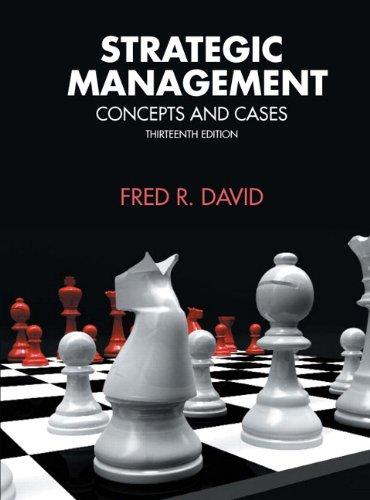It is important for representatives from all areas of a college or university to identify and discuss
Question:
It is important for representatives from all areas of a college or university to identify and discuss alternative strategies that could benefit faculty, students, alumni, staff, and other constituencies. As you complete this exercise, notice the learning and understanding that occurs as people express differences of opinion. Recall that the process of planning is more important than the document.
Instructions
Step 1 Recall or locate the external opportunity/threat and internal strength/weakness factors that you identified as part of Exercise 1B. If you did not do that exercise, discuss now as a class important external and internal factors facing your college or university.
Step 2 Identify and put on the chalkboard alternative strategies that you feel could benefit your college or university. Your proposed actions should allow the institution to capitalize on particular strengths, improve upon certain weaknesses, avoid external threats, and/or take advantage of particular external opportunities. List 10 possible strategies on the board. Number the strategies as they are written on the board.
Step 3 On a separate sheet of paper, number from 1 to 10. Everyone in class individually should rate the strategies identified, using a 1 to 3 scale, where 1 = I do not support implementation, 2 = I am neutral about implementation, and 3 = I strongly support implementation. In rating the strategies, recognize that your institution cannot do everything desired or potentially beneficial.
Step 4 Go to the board and record your ratings in a row beside the respective strategies. Everyone in class should do this, going to the board perhaps by rows in the class.
Step 5 Sum the ratings for each strategy so that a prioritized list of recommended strategies is obtained. This prioritized list reflects the collective wisdom of your class. Strategies with the highest score are deemed best.
Step 6 Discuss how this process could enable organizations to achieve understanding and commitment from individuals.
Step 7 Share your class results with a university administrator, and ask for comments regarding the process and top strategies recommended.
Data from Exercises 1B
External influences include trends in the following areas: economic, social, cultural, demographic, environmental, technological, political, legal, governmental, and competitive. External factors could include declining numbers of high school graduates; population shifts; community relations; increased competitiveness among colleges and universities; rising numbers of adults returning to college; decreased support from local, state, and federal agencies; increasing numbers of foreign students attending U.S. colleges; and a rising number of Internet courses.
Internal factors of a college or university include faculty, students, staff, alumni, athletic programs, physical plant, grounds and maintenance, student housing, administration, fundraising, academic programs, food services, parking, placement, clubs, fraternities, sororities, and public relations.
Step by Step Answer:

Strategic Management Concepts And Cases A Competitive Advantage Approach
ISBN: 9780136120988
13th Edition
Authors: Fred R. David





